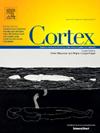无SMA病变的SMA样综合征:复发性低级别胶质瘤的结构和功能断开模式
IF 3.3
2区 心理学
Q1 BEHAVIORAL SCIENCES
引用次数: 0
摘要
辅助运动区综合征(SMA)是一种严重但短暂的综合征,可引起对侧运动障碍和语言缺陷,通常由辅助运动区(SMA)病变引起。通过功能和结构断开的方法,我们研究了病变相关的神经心理学症状是否可以用整个脑连接组的局部完整性丧失来解释。方法我们报告了一例53岁的男性患者,他接受了左外侧额下回以及额上回的切除术,以治疗低级别胶质瘤复发。虽然没有SMA病变,但他出现了SMA综合征的症状,包括言语停止和口吃,但患者恢复得很快,但部分恢复。第一次和第二次手术切除的空腔被用作研究病变网络映射(LNM)分析中结构和功能断开的电路的种子。作为对照,在LNM分析中加入SMA-complex区域。结果结构断连分析显示,第二次手术切除腔与SMA区在扣带和上纵束水平有常见的断连。此外,功能分析显示,在额顶叶和默认模式网络的关键枢纽,以及涉及备用SMA复合体的功能断开中,更大的二次手术引起的断开。根据hodo局部理论,尽管没有SMA病变,但SMA综合征似乎是由结构和功能脑回路的改变引起的。我们可以推测,互联网络的破坏可能是SMA综合征症状表现的基础,并可能为研究断开相关机制提供一个潜在的框架。本文章由计算机程序翻译,如有差异,请以英文原文为准。
SMA-like syndrome without SMA lesion: Patterns of structural and functional disconnection in a relapsing low grade glioma
Introduction
Supplementary Motor Area syndrome (SMAs), a severe but transient syndrome inducing contralateral akinesia and language deficits, typically arises from lesion involving the Supplementary Motor Area (SMA). Through a functional and structural disconnection approach, we investigated whether lesion-related neuropsychological symptoms could be explained in terms of hodotopical loss of integrity across the whole-brain connectome.
Method
We report a case of a 53-year-old man who underwent resection of the left lateral inferior frontal gyrus, as well as the middle and superior frontal gyri for a low-grade glioma recurrence. Although without SMA lesion, he developed SMA syndrome symptoms, including speech arrest and perseverations, the patient recovered quickly but partially. The resection cavities from the first and second surgery were used as seeds to investigate structurally and functionally disconnected circuits in a Lesion Network Mapping (LNM) analysis. As a control, SMA-complex region was included in LNM analysis.
Results
Structural disconnection analysis revealed common disconnections between second surgery resection cavity and SMA region, at the level of the Cingulate and Superior Longitudinal Fasciculus. Also, functional analysis showed greater second surgery induced disconnection in critical hubs of the Fronto-Parietal and Default Mode Networks, as well as functional disconnection involving the spared SMA complex.
Discussion
Here the SMA syndrome, emerged despite no SMA lesion, appears to results from an alteration of structural and functional brain circuits, according to the hodotopical theory. We can speculate that disruption of interconnected networks may underlie symptom manifestation in SMA syndrome and may offer a potential framework for studying disconnection-related mechanisms.
求助全文
通过发布文献求助,成功后即可免费获取论文全文。
去求助
来源期刊

Cortex
医学-行为科学
CiteScore
7.00
自引率
5.60%
发文量
250
审稿时长
74 days
期刊介绍:
CORTEX is an international journal devoted to the study of cognition and of the relationship between the nervous system and mental processes, particularly as these are reflected in the behaviour of patients with acquired brain lesions, normal volunteers, children with typical and atypical development, and in the activation of brain regions and systems as recorded by functional neuroimaging techniques. It was founded in 1964 by Ennio De Renzi.
 求助内容:
求助内容: 应助结果提醒方式:
应助结果提醒方式:


